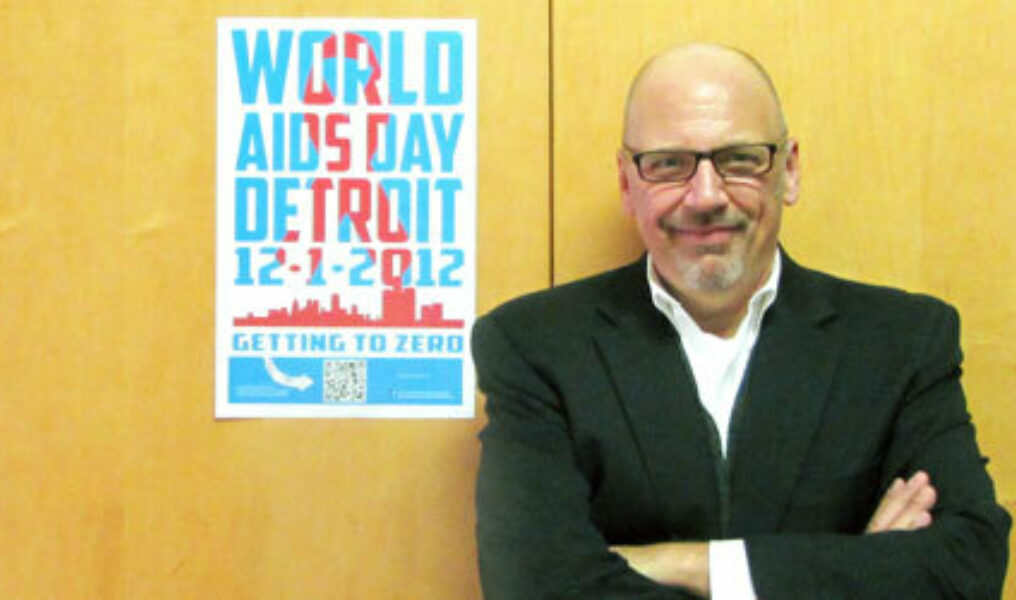
Detroit Department of Health and Wellness, the director of the HIV/AIDS program, Patrick Yankee. BTL photo: Crystal Proxmire.
DETROIT –
Sitting in an office that once housed tuberculosis and mental patients in the Herman Kiefer Health Complex that now serves as the headquarters for the Detroit Department of Health and Wellness, the director of the HIV/AIDS program, Patrick Yankee, looks out at crumbling buildings in the foreground of a skyline that is slowly gaining back its shine, and he sees his next frontier.
In the city of Detroit there are 5,579 known cases of HIV or AIDS, and an estimated 7,260. That's about a third of the known cases statewide, just in one city. Yankee's target area is six counties; Wayne, Oakland, Macomb, St. Clare, Lapeer and Monroe, with a total of 9,708 known cases and an estimated 12,630. His goal is to get those numbers down.
"Being here in Detroit means I can focus on a specific area and put all my effort toward that," he said. "I live in this area, and I thought I can contribute to the efforts here." His full title is Director of the Southeastern Michigan Health Association in Association with Detroit Department of Health and Wellness Promotion HIV/AIDS Program. And his main responsibility is working with area organizations to divvy up federal program money and to make sure that progress is being made.
His appointment is unique in that this is the first time a gay person has taken on the task. He's also the first male.
One of his big concerns is that the largest percentage of infections continues to be in the gay community. MSMs (Men who have Sex with Men) make up 53 percent of all reported cases of HIV in Detroit according to the eHARS (enhanced HIV/AIDS Reporting System). "We look at how we can reduce infections, and what strategies we can use to prevent the most infections from occurring," he said.
After MSMs, heterosexual categories make up 17 percent of reported cases, with females making up 82 percent of this group. Injection drug users are 15 percent, though there is overlap between injection drug users and people who fall into other categories as well.
The Ryan White HIV/AIDS Program is the main vehicle for funding, and it's those dollars that Yankee and his office are responsible for dispersing and tracking. With just $9 million to allocate between about 25 agencies, there are tough decisions to be made. Ryan White provides "medical care, treatment and medications along with support services to people living with HIV/AIDS who are unable to access treatment and care from other sources." Part A provides funding to major cities, like Detroit. Part B is for state grants, including the funding of the state AIDS Drug Assistance Programs. Part C focuseson early intervention and primary care. Part D focuses on comprehensive care and research for children, youth, women and families. And Part F focuses on special projects like dental reimbursement and educational training centers.
With the money allocated for the greater Detroit area, 75 percent must go for medical services and 25 percent must go for support and prevention.
In addition to the $9 million from Ryan White, Yankee also oversees funding for HOPWA, Housing Opportunities for People with AIDS.
Having a limited number of funds and multiple service organizations can be a challenge, especially when there are multiple agencies that do similar things. "Unfortunately there is a lot of fatigue," Yankee said. "Fatigue in not having enough resources. Nonprofits in general are expected to perform miracles with very little. There's also fatigue because we've been forced into competition. It's not intentional, but it is a system that prevents cooperation."
Yankee's vision is to bring organizations together and look for ways to bring costs down, and also for ways to make sure that funding is reaching the right people. "We've got all this data, and we've been studying zip codes to find out very specifically who we need to reach out to. We need to streamline services and bring unity as much as possible. I know the passion and brains and talent in our community are there to fix this….I want to turn the page with service providers to open dialogue and use data to close gaps."
One way to reduce the prevalence of HIV/AIDS is to catch infections early and get people into treatment. "Our goal is to link a newly diagnosed person to get medical care within 90 days," he said. "There is a big interest in getting people to care. You do not need insurance to be seen by a doctor. Treatment for people with HIV is completely covered for many people if their income is $45,000 a year or less." There are multiple other programs that can help with costs of medicine and care.
Based on laboratory reporting, Yankee can estimate that of the 9,708 patients in the six counties, as many as 3,000 have not had a medical visit in the last year. While there is an obvious concern for the health of those individuals, early treatment has an additional benefit. "When someone is in treatment, the amount of the virus in their blood is lower, and the risk of transmission is lower too. Getting people into treatment means they are less likely to infect other people."
Stopping the spread through treating the disease is one of the reasons why 75 percent of Ryan White funding goes towards medical care. It's also why Yankee hopes to do more targeted efforts to reach people who are infected, both by zip code and by reaching out more in the gay community.
One barrier to this, however, is economic.
"This is a disease of poverty," Yankee said. "When someone has money problems, housing problems, mental health issues, not having enough to eat, getting treatment may be lower on their list of priorities. That's why we need to work well with each other, and other agencies that provide services to people in need in general. Our goal is to reduce that out of care number, so we need to be able to connect people to whatever support they need.
"People with HIV and AIDS are still on the outside looking in. We have awesome medical care in this community. My concern is that people don't find their way there."
Yankee started with the Detroit Health Department in late August, but has spent his life doing HIV/AIDS work, going back to the beginning of the epidemic. "I started out as a volunteer for HARC (HIV/AIDS Resource Center) in 1985/86 and I was on the board of Wellness Huron Valley. All we did in the early days was train volunteers. To start we had move volunteers than cases, but we knew the epidemic was coming and we just tried to learn all we could and reach out to as many people as possible."
When he was 23 years old his friends were getting sick, and dying quickly. "My oldest sister and dear friend died of brain cancer," Yankee said. "She was the first person I came out to when I was 14. She said 'It's good, it's fine.' She held a special place for me and I feel like I owe her. I came home from the funeral and turned the key and I heard the phone ringing inside. A close friend's partner called and said if you want to see them again you need to get to the hospital. He was dead less than a week later. So I quit my job and went to the Wellness network. I worked two part time jobs just so I could volunteer there." In 1990 he became the first director of HARC, a position he held for about 10 years, and has spent most of the past ten years at the State Health Department.
He said that having a small geographic area and a concentrated number of cases is helping him maintain his passion for AIDS work. "I've always worked hard, but here I feel creative again."
For more information about the Detroit Department of Health and Wellness Promotion HIV/AIDS program visit their website at http://www.detroitmi.gov/DepartmentsandAgencies/DepartmentofHealthWellnessPromotion/Programs/HIVAIDS.aspx.










